Nursing Assignment: Aged Care Services in Australia and WHO Model
VerifiedAdded on 2023/06/03
|14
|4816
|480
Essay
AI Summary
This nursing assignment delves into the complexities of aging and the importance of effective aged care services. It begins by introducing the WHO Healthy Aging Model, outlining its objectives and strategies for promoting healthy and sustainable aging globally. The paper then explores the organization of aged care services in Australia, focusing on how the Australian healthcare sector has adopted and implemented the WHO model, particularly through the Intrinsic Care Pathway (ICP) framework. The discussion includes an analysis of the ICP framework's efficacy in enhancing care provision, improving communication, and coordinating care among stakeholders. The assignment also highlights government strategies aimed at making environments accessible for the elderly, promoting their contributions to policies, fostering emotional and financial security, and supporting their overall growth within society. The paper emphasizes the importance of aligning healthcare systems with the WHO Healthy Aging Model to meet the specific needs of the aging population and transform the provision of clinical and healthcare services to ensure integrated and affordable healthcare globally.
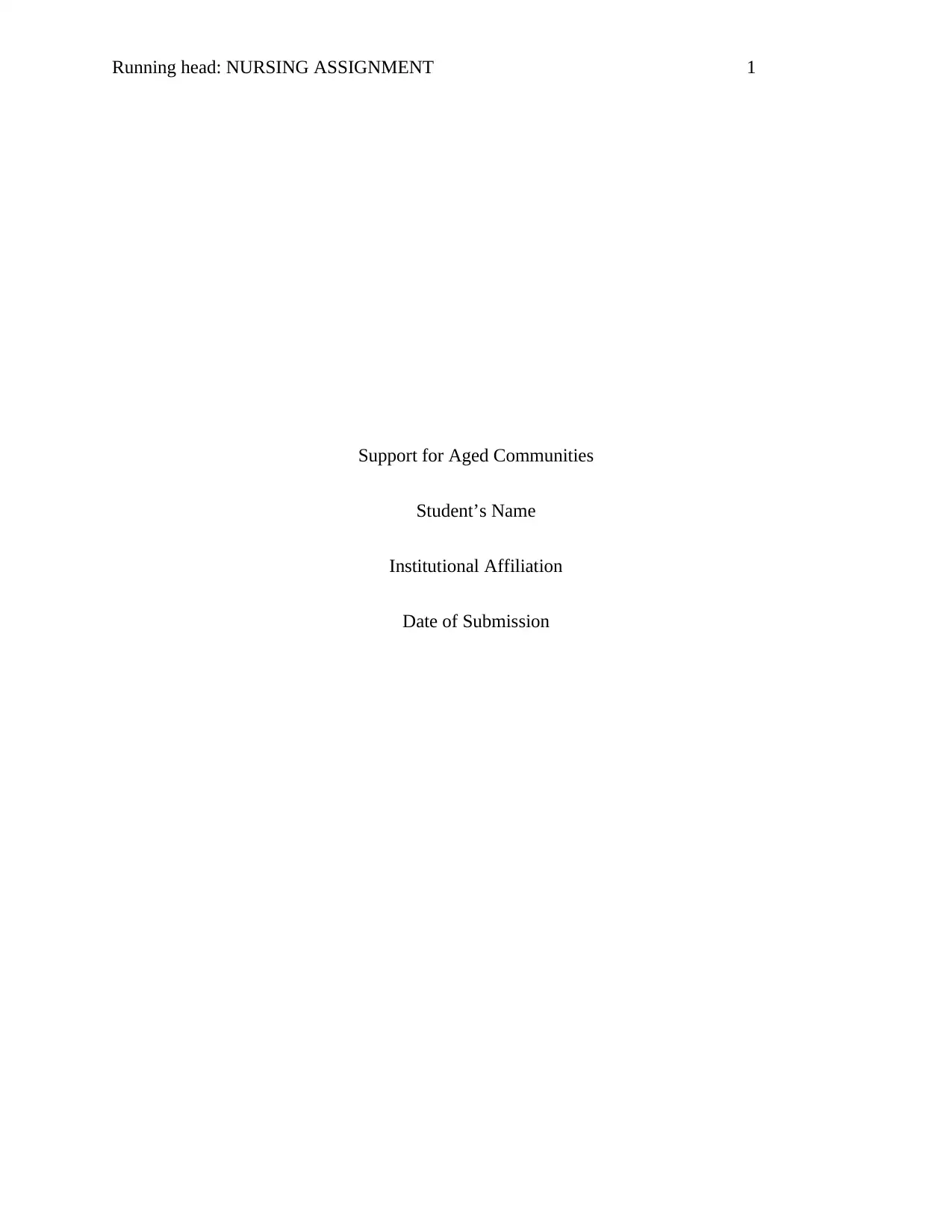
Running head: NURSING ASSIGNMENT 1
Support for Aged Communities
Student’s Name
Institutional Affiliation
Date of Submission
Support for Aged Communities
Student’s Name
Institutional Affiliation
Date of Submission
Paraphrase This Document
Need a fresh take? Get an instant paraphrase of this document with our AI Paraphraser

NURSING ASSIGNMENT 2
1. INTRODUCTION
Being old comes with many challenges. For instance, old people’s health and well-being
significantly deteriorate with age. By so saying, the WHO reports on “Healthy Aging” show that
aged individuals are prone to several health complications compared to younger people.
Individuals are thus, encouraged to be responsible in managing their heaths and well-being.
Secondly, everyone should take occasional medical checks, old and young alike to manage
illnesses and diseases as well as impacts on daily life and behavior (WHO, 2017). Apart from
that, being in a position to use health related information to practice healthy living is important in
the management of health. On the contrary, low knowledge levels on healthy living is mostly
likely to lead to poorer health outcomes, health services, and low proper medication adherence.
In the management of aging and health issues, aged people with multiple health concerns always
tend to several medication regime that may increase their health risks (UNDESA, 2016).
This essay paper will therefore start with explaining the WHO Healthy Aging Model
while providing an overview of WHO research evidences on the aging determinants as described
by the model. In relation to the discussed model, the activity will roll out several programs,
strategies, and approaches all of which are targeted towards living healthy lives as far as aged
individuals are concerned. Afterwards, the paper shall discuss the manner in which aged care
services are organized in Australia alongside provision of analysis on how Australian health care
facilities are organized in line with the WHO Aging Model (Bateson, Et al., 2014, pg. 156).
Otherwise, this activity will also touch on the efficacy of using healthy programs in ensuring that
the needs of aged individuals are met. Other aspects of discussion shall include:
1. INTRODUCTION
Being old comes with many challenges. For instance, old people’s health and well-being
significantly deteriorate with age. By so saying, the WHO reports on “Healthy Aging” show that
aged individuals are prone to several health complications compared to younger people.
Individuals are thus, encouraged to be responsible in managing their heaths and well-being.
Secondly, everyone should take occasional medical checks, old and young alike to manage
illnesses and diseases as well as impacts on daily life and behavior (WHO, 2017). Apart from
that, being in a position to use health related information to practice healthy living is important in
the management of health. On the contrary, low knowledge levels on healthy living is mostly
likely to lead to poorer health outcomes, health services, and low proper medication adherence.
In the management of aging and health issues, aged people with multiple health concerns always
tend to several medication regime that may increase their health risks (UNDESA, 2016).
This essay paper will therefore start with explaining the WHO Healthy Aging Model
while providing an overview of WHO research evidences on the aging determinants as described
by the model. In relation to the discussed model, the activity will roll out several programs,
strategies, and approaches all of which are targeted towards living healthy lives as far as aged
individuals are concerned. Afterwards, the paper shall discuss the manner in which aged care
services are organized in Australia alongside provision of analysis on how Australian health care
facilities are organized in line with the WHO Aging Model (Bateson, Et al., 2014, pg. 156).
Otherwise, this activity will also touch on the efficacy of using healthy programs in ensuring that
the needs of aged individuals are met. Other aspects of discussion shall include:
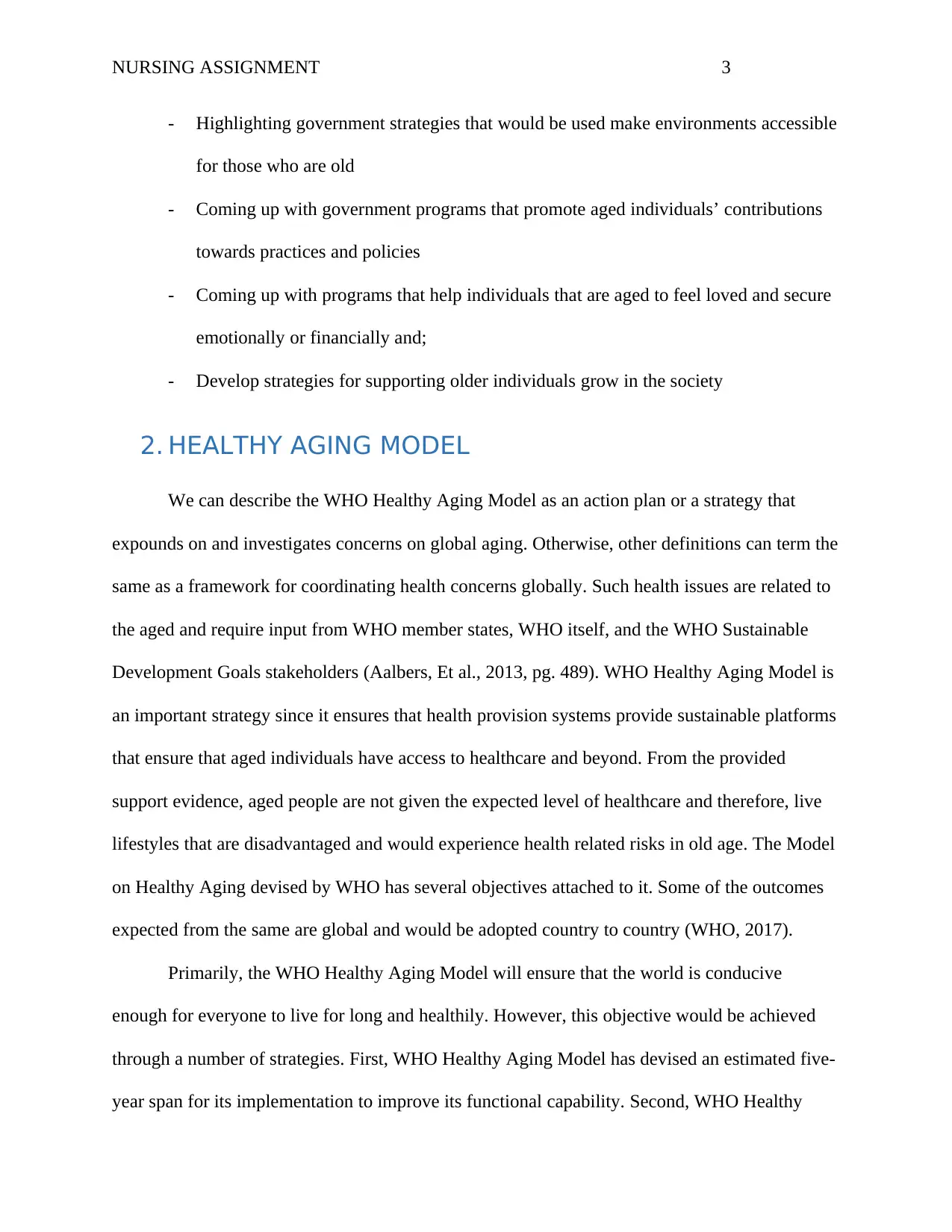
NURSING ASSIGNMENT 3
- Highlighting government strategies that would be used make environments accessible
for those who are old
- Coming up with government programs that promote aged individuals’ contributions
towards practices and policies
- Coming up with programs that help individuals that are aged to feel loved and secure
emotionally or financially and;
- Develop strategies for supporting older individuals grow in the society
2. HEALTHY AGING MODEL
We can describe the WHO Healthy Aging Model as an action plan or a strategy that
expounds on and investigates concerns on global aging. Otherwise, other definitions can term the
same as a framework for coordinating health concerns globally. Such health issues are related to
the aged and require input from WHO member states, WHO itself, and the WHO Sustainable
Development Goals stakeholders (Aalbers, Et al., 2013, pg. 489). WHO Healthy Aging Model is
an important strategy since it ensures that health provision systems provide sustainable platforms
that ensure that aged individuals have access to healthcare and beyond. From the provided
support evidence, aged people are not given the expected level of healthcare and therefore, live
lifestyles that are disadvantaged and would experience health related risks in old age. The Model
on Healthy Aging devised by WHO has several objectives attached to it. Some of the outcomes
expected from the same are global and would be adopted country to country (WHO, 2017).
Primarily, the WHO Healthy Aging Model will ensure that the world is conducive
enough for everyone to live for long and healthily. However, this objective would be achieved
through a number of strategies. First, WHO Healthy Aging Model has devised an estimated five-
year span for its implementation to improve its functional capability. Second, WHO Healthy
- Highlighting government strategies that would be used make environments accessible
for those who are old
- Coming up with government programs that promote aged individuals’ contributions
towards practices and policies
- Coming up with programs that help individuals that are aged to feel loved and secure
emotionally or financially and;
- Develop strategies for supporting older individuals grow in the society
2. HEALTHY AGING MODEL
We can describe the WHO Healthy Aging Model as an action plan or a strategy that
expounds on and investigates concerns on global aging. Otherwise, other definitions can term the
same as a framework for coordinating health concerns globally. Such health issues are related to
the aged and require input from WHO member states, WHO itself, and the WHO Sustainable
Development Goals stakeholders (Aalbers, Et al., 2013, pg. 489). WHO Healthy Aging Model is
an important strategy since it ensures that health provision systems provide sustainable platforms
that ensure that aged individuals have access to healthcare and beyond. From the provided
support evidence, aged people are not given the expected level of healthcare and therefore, live
lifestyles that are disadvantaged and would experience health related risks in old age. The Model
on Healthy Aging devised by WHO has several objectives attached to it. Some of the outcomes
expected from the same are global and would be adopted country to country (WHO, 2017).
Primarily, the WHO Healthy Aging Model will ensure that the world is conducive
enough for everyone to live for long and healthily. However, this objective would be achieved
through a number of strategies. First, WHO Healthy Aging Model has devised an estimated five-
year span for its implementation to improve its functional capability. Second, WHO Healthy
⊘ This is a preview!⊘
Do you want full access?
Subscribe today to unlock all pages.

Trusted by 1+ million students worldwide
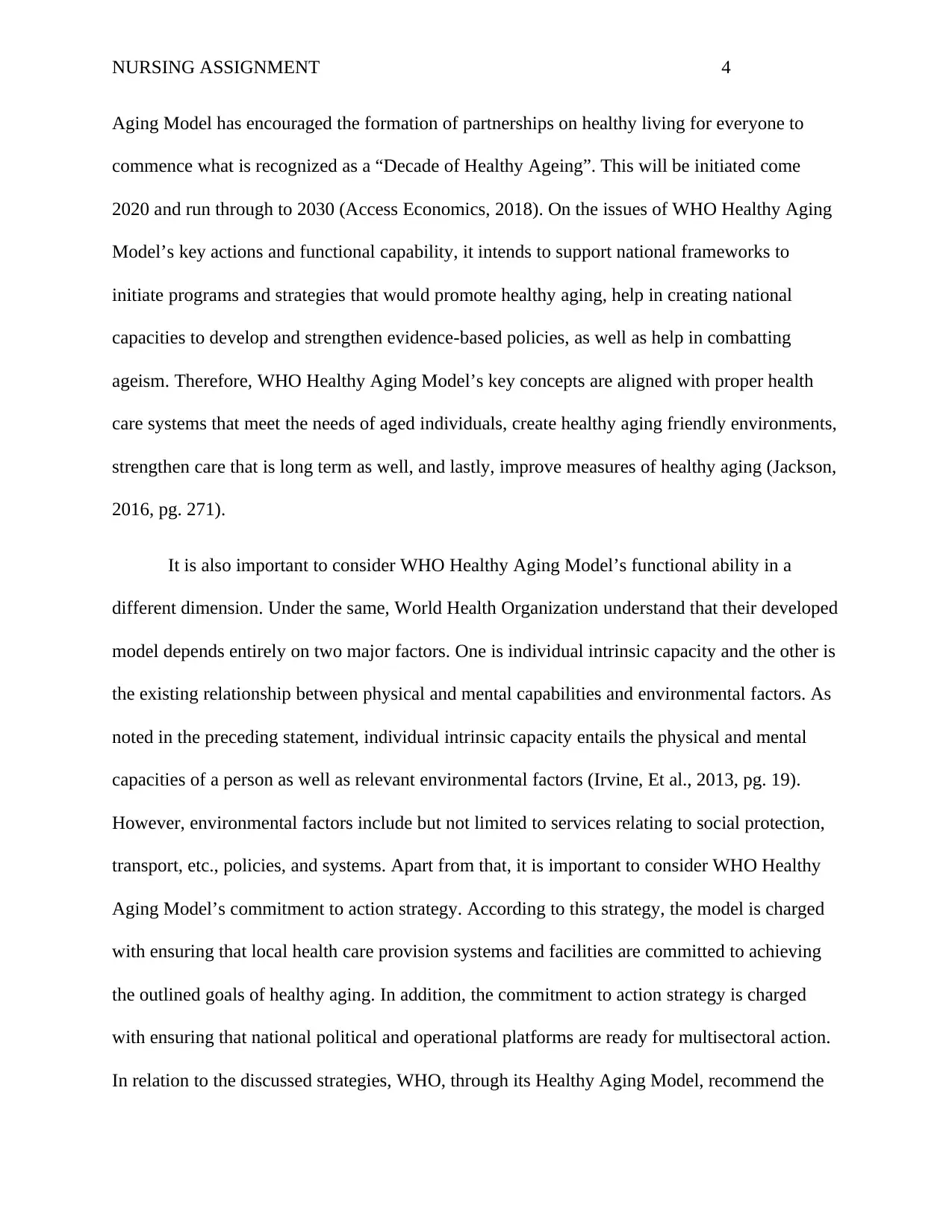
NURSING ASSIGNMENT 4
Aging Model has encouraged the formation of partnerships on healthy living for everyone to
commence what is recognized as a “Decade of Healthy Ageing”. This will be initiated come
2020 and run through to 2030 (Access Economics, 2018). On the issues of WHO Healthy Aging
Model’s key actions and functional capability, it intends to support national frameworks to
initiate programs and strategies that would promote healthy aging, help in creating national
capacities to develop and strengthen evidence-based policies, as well as help in combatting
ageism. Therefore, WHO Healthy Aging Model’s key concepts are aligned with proper health
care systems that meet the needs of aged individuals, create healthy aging friendly environments,
strengthen care that is long term as well, and lastly, improve measures of healthy aging (Jackson,
2016, pg. 271).
It is also important to consider WHO Healthy Aging Model’s functional ability in a
different dimension. Under the same, World Health Organization understand that their developed
model depends entirely on two major factors. One is individual intrinsic capacity and the other is
the existing relationship between physical and mental capabilities and environmental factors. As
noted in the preceding statement, individual intrinsic capacity entails the physical and mental
capacities of a person as well as relevant environmental factors (Irvine, Et al., 2013, pg. 19).
However, environmental factors include but not limited to services relating to social protection,
transport, etc., policies, and systems. Apart from that, it is important to consider WHO Healthy
Aging Model’s commitment to action strategy. According to this strategy, the model is charged
with ensuring that local health care provision systems and facilities are committed to achieving
the outlined goals of healthy aging. In addition, the commitment to action strategy is charged
with ensuring that national political and operational platforms are ready for multisectoral action.
In relation to the discussed strategies, WHO, through its Healthy Aging Model, recommend the
Aging Model has encouraged the formation of partnerships on healthy living for everyone to
commence what is recognized as a “Decade of Healthy Ageing”. This will be initiated come
2020 and run through to 2030 (Access Economics, 2018). On the issues of WHO Healthy Aging
Model’s key actions and functional capability, it intends to support national frameworks to
initiate programs and strategies that would promote healthy aging, help in creating national
capacities to develop and strengthen evidence-based policies, as well as help in combatting
ageism. Therefore, WHO Healthy Aging Model’s key concepts are aligned with proper health
care systems that meet the needs of aged individuals, create healthy aging friendly environments,
strengthen care that is long term as well, and lastly, improve measures of healthy aging (Jackson,
2016, pg. 271).
It is also important to consider WHO Healthy Aging Model’s functional ability in a
different dimension. Under the same, World Health Organization understand that their developed
model depends entirely on two major factors. One is individual intrinsic capacity and the other is
the existing relationship between physical and mental capabilities and environmental factors. As
noted in the preceding statement, individual intrinsic capacity entails the physical and mental
capacities of a person as well as relevant environmental factors (Irvine, Et al., 2013, pg. 19).
However, environmental factors include but not limited to services relating to social protection,
transport, etc., policies, and systems. Apart from that, it is important to consider WHO Healthy
Aging Model’s commitment to action strategy. According to this strategy, the model is charged
with ensuring that local health care provision systems and facilities are committed to achieving
the outlined goals of healthy aging. In addition, the commitment to action strategy is charged
with ensuring that national political and operational platforms are ready for multisectoral action.
In relation to the discussed strategies, WHO, through its Healthy Aging Model, recommend the
Paraphrase This Document
Need a fresh take? Get an instant paraphrase of this document with our AI Paraphraser
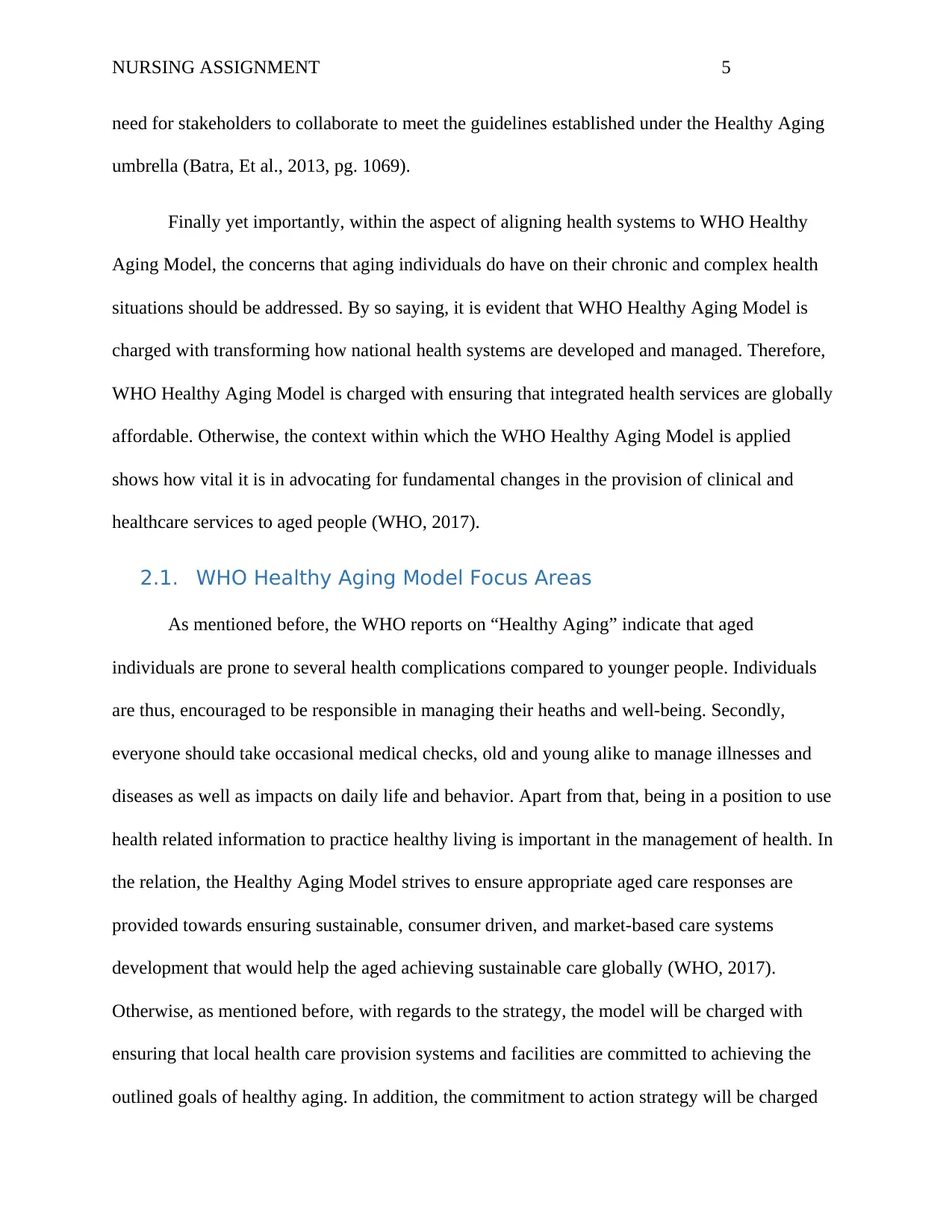
NURSING ASSIGNMENT 5
need for stakeholders to collaborate to meet the guidelines established under the Healthy Aging
umbrella (Batra, Et al., 2013, pg. 1069).
Finally yet importantly, within the aspect of aligning health systems to WHO Healthy
Aging Model, the concerns that aging individuals do have on their chronic and complex health
situations should be addressed. By so saying, it is evident that WHO Healthy Aging Model is
charged with transforming how national health systems are developed and managed. Therefore,
WHO Healthy Aging Model is charged with ensuring that integrated health services are globally
affordable. Otherwise, the context within which the WHO Healthy Aging Model is applied
shows how vital it is in advocating for fundamental changes in the provision of clinical and
healthcare services to aged people (WHO, 2017).
2.1. WHO Healthy Aging Model Focus Areas
As mentioned before, the WHO reports on “Healthy Aging” indicate that aged
individuals are prone to several health complications compared to younger people. Individuals
are thus, encouraged to be responsible in managing their heaths and well-being. Secondly,
everyone should take occasional medical checks, old and young alike to manage illnesses and
diseases as well as impacts on daily life and behavior. Apart from that, being in a position to use
health related information to practice healthy living is important in the management of health. In
the relation, the Healthy Aging Model strives to ensure appropriate aged care responses are
provided towards ensuring sustainable, consumer driven, and market-based care systems
development that would help the aged achieving sustainable care globally (WHO, 2017).
Otherwise, as mentioned before, with regards to the strategy, the model will be charged with
ensuring that local health care provision systems and facilities are committed to achieving the
outlined goals of healthy aging. In addition, the commitment to action strategy will be charged
need for stakeholders to collaborate to meet the guidelines established under the Healthy Aging
umbrella (Batra, Et al., 2013, pg. 1069).
Finally yet importantly, within the aspect of aligning health systems to WHO Healthy
Aging Model, the concerns that aging individuals do have on their chronic and complex health
situations should be addressed. By so saying, it is evident that WHO Healthy Aging Model is
charged with transforming how national health systems are developed and managed. Therefore,
WHO Healthy Aging Model is charged with ensuring that integrated health services are globally
affordable. Otherwise, the context within which the WHO Healthy Aging Model is applied
shows how vital it is in advocating for fundamental changes in the provision of clinical and
healthcare services to aged people (WHO, 2017).
2.1. WHO Healthy Aging Model Focus Areas
As mentioned before, the WHO reports on “Healthy Aging” indicate that aged
individuals are prone to several health complications compared to younger people. Individuals
are thus, encouraged to be responsible in managing their heaths and well-being. Secondly,
everyone should take occasional medical checks, old and young alike to manage illnesses and
diseases as well as impacts on daily life and behavior. Apart from that, being in a position to use
health related information to practice healthy living is important in the management of health. In
the relation, the Healthy Aging Model strives to ensure appropriate aged care responses are
provided towards ensuring sustainable, consumer driven, and market-based care systems
development that would help the aged achieving sustainable care globally (WHO, 2017).
Otherwise, as mentioned before, with regards to the strategy, the model will be charged with
ensuring that local health care provision systems and facilities are committed to achieving the
outlined goals of healthy aging. In addition, the commitment to action strategy will be charged

NURSING ASSIGNMENT 6
with ensuring that national political and operational platforms are ready for multisectoral action.
In relation to the same, the Model’s key concepts are aligned with proper health care systems to
meet the needs of aged individuals, create healthy aging friendly environments, strengthen care
that is long term as well, and lastly, improve measures of healthy aging (Australian Bureau of
Statistics, 2015).
3. DISCUSSION AND ANALYSIS OF AGED CARE
SERVICES ORGANIZATION IN AUSTRALIA
3.1. Discussion
In the sections above, the paper introduced the WHO Healthy Aging Model and
discussed its importance and employment. In relation to the same, this section will identify how
the Australian health care provision sector has employed the WHO Healthy Aging Model, used
related programs and strategies, as well as organized the health sector to meet the WHO Healthy
Aging Model goals (Bloom, 2017, pg. 567).
In line with WHO Healthy Aging Model, the health sector of Australia has employed the
Intrinsic Care Pathway (ICP) framework to effectively provide aged care and meet the goals of
WHO Healthy Aging Model. ICP framework has proved to be important in care provision
centers in Australia since nurses and care providers use the same framework to monitor aged
individuals, the frail, as well as those that are disabled. Apart from that, the introduction of the
ICP framework ensures that providers of care are well positioned to establish proper care
provisions are recommended by the WHO Healthy Aging Model as well as ensure that the right,
needful steps are offered to those that need it. By the government of Australia approving the
adoption of WHO Healthy Aging Model in the health care provision areas, is a gesture that it
upholds the vitality of providing evidence-based care practices and making them accessible to
with ensuring that national political and operational platforms are ready for multisectoral action.
In relation to the same, the Model’s key concepts are aligned with proper health care systems to
meet the needs of aged individuals, create healthy aging friendly environments, strengthen care
that is long term as well, and lastly, improve measures of healthy aging (Australian Bureau of
Statistics, 2015).
3. DISCUSSION AND ANALYSIS OF AGED CARE
SERVICES ORGANIZATION IN AUSTRALIA
3.1. Discussion
In the sections above, the paper introduced the WHO Healthy Aging Model and
discussed its importance and employment. In relation to the same, this section will identify how
the Australian health care provision sector has employed the WHO Healthy Aging Model, used
related programs and strategies, as well as organized the health sector to meet the WHO Healthy
Aging Model goals (Bloom, 2017, pg. 567).
In line with WHO Healthy Aging Model, the health sector of Australia has employed the
Intrinsic Care Pathway (ICP) framework to effectively provide aged care and meet the goals of
WHO Healthy Aging Model. ICP framework has proved to be important in care provision
centers in Australia since nurses and care providers use the same framework to monitor aged
individuals, the frail, as well as those that are disabled. Apart from that, the introduction of the
ICP framework ensures that providers of care are well positioned to establish proper care
provisions are recommended by the WHO Healthy Aging Model as well as ensure that the right,
needful steps are offered to those that need it. By the government of Australia approving the
adoption of WHO Healthy Aging Model in the health care provision areas, is a gesture that it
upholds the vitality of providing evidence-based care practices and making them accessible to
⊘ This is a preview!⊘
Do you want full access?
Subscribe today to unlock all pages.

Trusted by 1+ million students worldwide
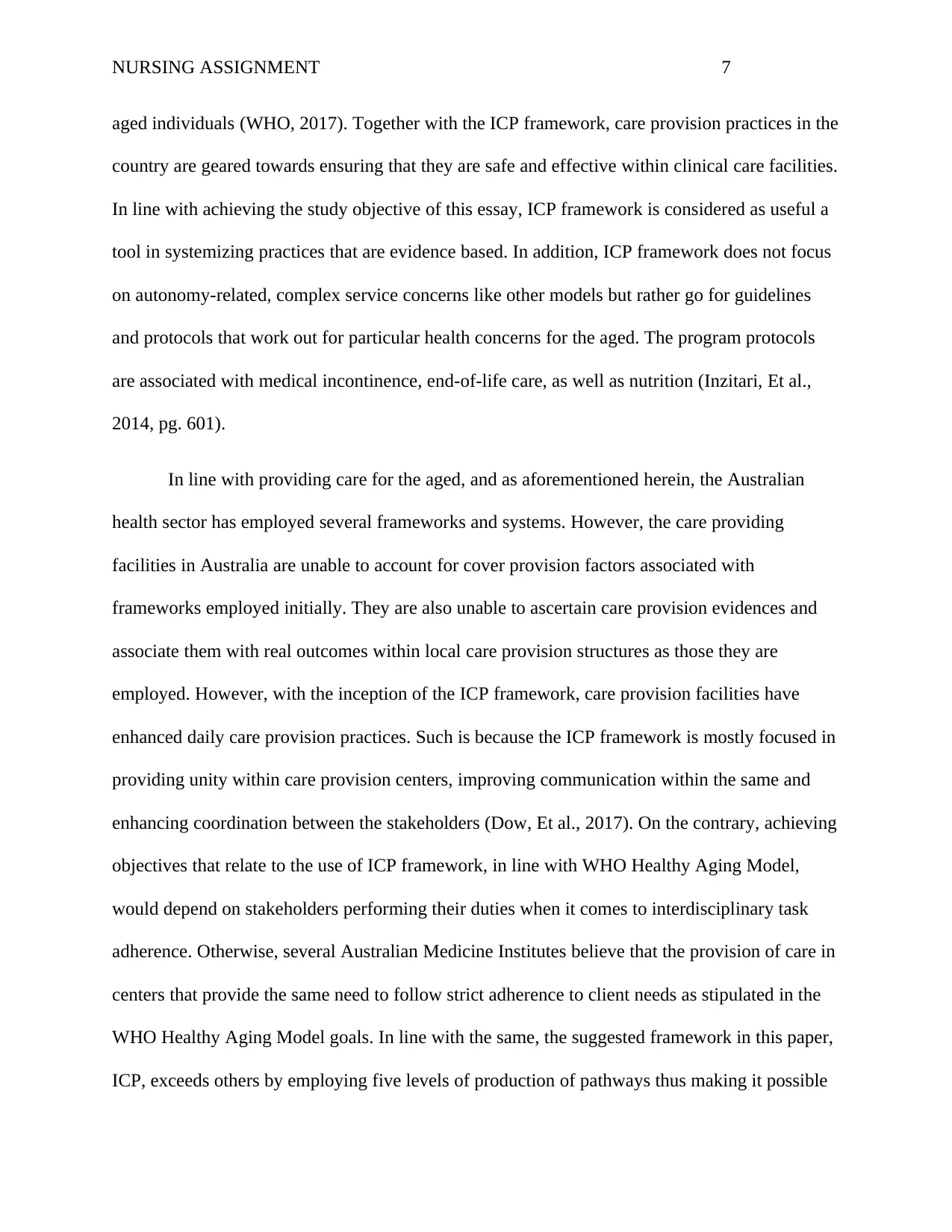
NURSING ASSIGNMENT 7
aged individuals (WHO, 2017). Together with the ICP framework, care provision practices in the
country are geared towards ensuring that they are safe and effective within clinical care facilities.
In line with achieving the study objective of this essay, ICP framework is considered as useful a
tool in systemizing practices that are evidence based. In addition, ICP framework does not focus
on autonomy-related, complex service concerns like other models but rather go for guidelines
and protocols that work out for particular health concerns for the aged. The program protocols
are associated with medical incontinence, end-of-life care, as well as nutrition (Inzitari, Et al.,
2014, pg. 601).
In line with providing care for the aged, and as aforementioned herein, the Australian
health sector has employed several frameworks and systems. However, the care providing
facilities in Australia are unable to account for cover provision factors associated with
frameworks employed initially. They are also unable to ascertain care provision evidences and
associate them with real outcomes within local care provision structures as those they are
employed. However, with the inception of the ICP framework, care provision facilities have
enhanced daily care provision practices. Such is because the ICP framework is mostly focused in
providing unity within care provision centers, improving communication within the same and
enhancing coordination between the stakeholders (Dow, Et al., 2017). On the contrary, achieving
objectives that relate to the use of ICP framework, in line with WHO Healthy Aging Model,
would depend on stakeholders performing their duties when it comes to interdisciplinary task
adherence. Otherwise, several Australian Medicine Institutes believe that the provision of care in
centers that provide the same need to follow strict adherence to client needs as stipulated in the
WHO Healthy Aging Model goals. In line with the same, the suggested framework in this paper,
ICP, exceeds others by employing five levels of production of pathways thus making it possible
aged individuals (WHO, 2017). Together with the ICP framework, care provision practices in the
country are geared towards ensuring that they are safe and effective within clinical care facilities.
In line with achieving the study objective of this essay, ICP framework is considered as useful a
tool in systemizing practices that are evidence based. In addition, ICP framework does not focus
on autonomy-related, complex service concerns like other models but rather go for guidelines
and protocols that work out for particular health concerns for the aged. The program protocols
are associated with medical incontinence, end-of-life care, as well as nutrition (Inzitari, Et al.,
2014, pg. 601).
In line with providing care for the aged, and as aforementioned herein, the Australian
health sector has employed several frameworks and systems. However, the care providing
facilities in Australia are unable to account for cover provision factors associated with
frameworks employed initially. They are also unable to ascertain care provision evidences and
associate them with real outcomes within local care provision structures as those they are
employed. However, with the inception of the ICP framework, care provision facilities have
enhanced daily care provision practices. Such is because the ICP framework is mostly focused in
providing unity within care provision centers, improving communication within the same and
enhancing coordination between the stakeholders (Dow, Et al., 2017). On the contrary, achieving
objectives that relate to the use of ICP framework, in line with WHO Healthy Aging Model,
would depend on stakeholders performing their duties when it comes to interdisciplinary task
adherence. Otherwise, several Australian Medicine Institutes believe that the provision of care in
centers that provide the same need to follow strict adherence to client needs as stipulated in the
WHO Healthy Aging Model goals. In line with the same, the suggested framework in this paper,
ICP, exceeds others by employing five levels of production of pathways thus making it possible
Paraphrase This Document
Need a fresh take? Get an instant paraphrase of this document with our AI Paraphraser
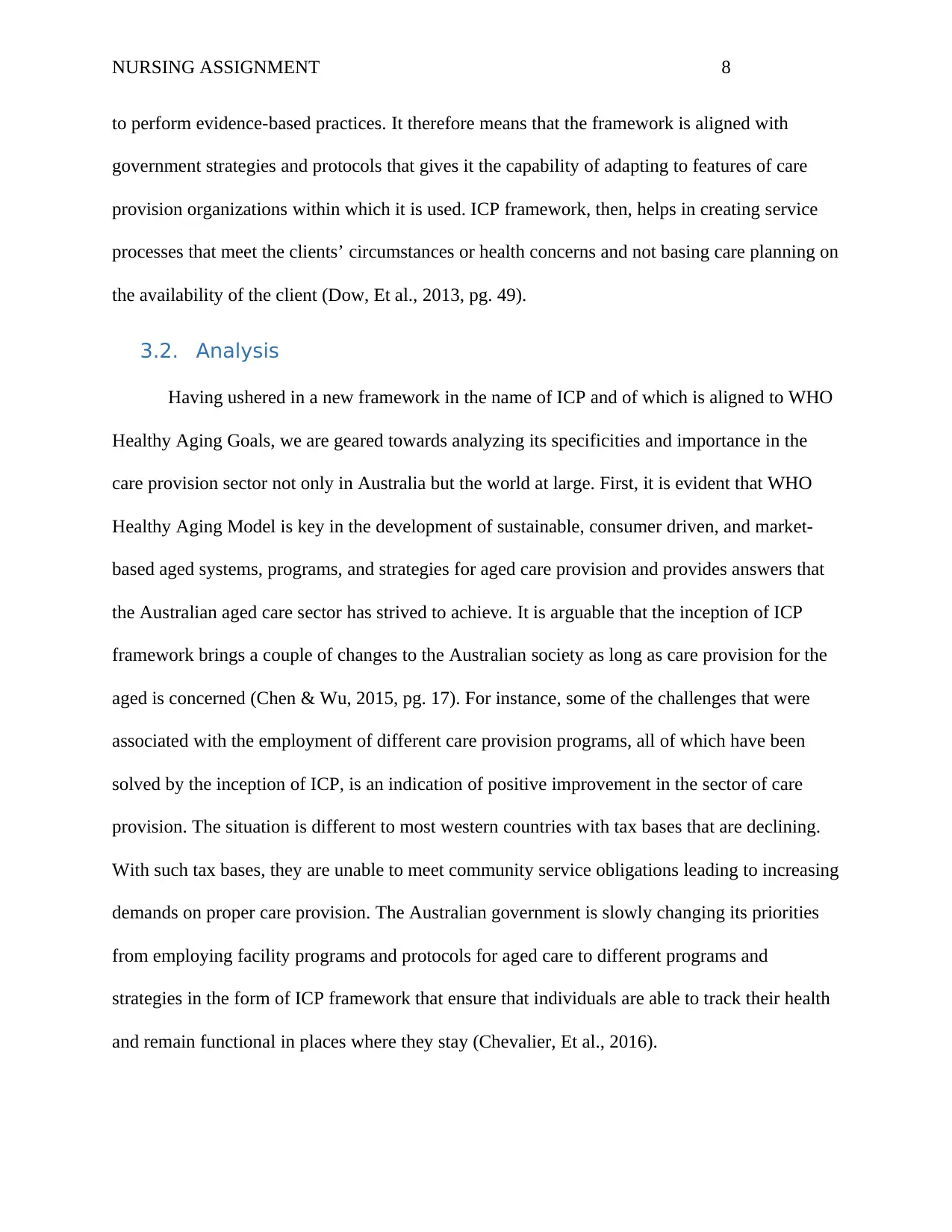
NURSING ASSIGNMENT 8
to perform evidence-based practices. It therefore means that the framework is aligned with
government strategies and protocols that gives it the capability of adapting to features of care
provision organizations within which it is used. ICP framework, then, helps in creating service
processes that meet the clients’ circumstances or health concerns and not basing care planning on
the availability of the client (Dow, Et al., 2013, pg. 49).
3.2. Analysis
Having ushered in a new framework in the name of ICP and of which is aligned to WHO
Healthy Aging Goals, we are geared towards analyzing its specificities and importance in the
care provision sector not only in Australia but the world at large. First, it is evident that WHO
Healthy Aging Model is key in the development of sustainable, consumer driven, and market-
based aged systems, programs, and strategies for aged care provision and provides answers that
the Australian aged care sector has strived to achieve. It is arguable that the inception of ICP
framework brings a couple of changes to the Australian society as long as care provision for the
aged is concerned (Chen & Wu, 2015, pg. 17). For instance, some of the challenges that were
associated with the employment of different care provision programs, all of which have been
solved by the inception of ICP, is an indication of positive improvement in the sector of care
provision. The situation is different to most western countries with tax bases that are declining.
With such tax bases, they are unable to meet community service obligations leading to increasing
demands on proper care provision. The Australian government is slowly changing its priorities
from employing facility programs and protocols for aged care to different programs and
strategies in the form of ICP framework that ensure that individuals are able to track their health
and remain functional in places where they stay (Chevalier, Et al., 2016).
to perform evidence-based practices. It therefore means that the framework is aligned with
government strategies and protocols that gives it the capability of adapting to features of care
provision organizations within which it is used. ICP framework, then, helps in creating service
processes that meet the clients’ circumstances or health concerns and not basing care planning on
the availability of the client (Dow, Et al., 2013, pg. 49).
3.2. Analysis
Having ushered in a new framework in the name of ICP and of which is aligned to WHO
Healthy Aging Goals, we are geared towards analyzing its specificities and importance in the
care provision sector not only in Australia but the world at large. First, it is evident that WHO
Healthy Aging Model is key in the development of sustainable, consumer driven, and market-
based aged systems, programs, and strategies for aged care provision and provides answers that
the Australian aged care sector has strived to achieve. It is arguable that the inception of ICP
framework brings a couple of changes to the Australian society as long as care provision for the
aged is concerned (Chen & Wu, 2015, pg. 17). For instance, some of the challenges that were
associated with the employment of different care provision programs, all of which have been
solved by the inception of ICP, is an indication of positive improvement in the sector of care
provision. The situation is different to most western countries with tax bases that are declining.
With such tax bases, they are unable to meet community service obligations leading to increasing
demands on proper care provision. The Australian government is slowly changing its priorities
from employing facility programs and protocols for aged care to different programs and
strategies in the form of ICP framework that ensure that individuals are able to track their health
and remain functional in places where they stay (Chevalier, Et al., 2016).

NURSING ASSIGNMENT 9
Also, should be noted that ICP is a multidisciplinary, structured plan and framework with
detailed steps on how to provide quality care for patients and aged individuals with health issues
as outlined in the WHO Healthy Aging Model. The reason behind proposing this framework is
the fact that it is capable of outlining appropriate mechanisms that would help in implementing
national care provision guidelines in line with the goals of WHO’s Healthy Aging Model and
thus, benefit to a greater deal, aged and ill individuals. It also helps in applying subsequent
clinical practice guidelines (Adler & Rottunda, 2016, pg. 229). ICP framework would improve
systematic application and abstraction of clinical data that otherwise promote audit practices and
healthy living. In Australia, several frameworks and initiatives have been introduced for the
improvisation of clinical effectiveness yet ICP has been branded as the best strategy and
framework for providing care for the old (Aalbers, Et al., 2013, pg. 491). As discussed, most of
such models have proven to contain a number of shortcomings with regards to meeting WHO
Healthy Aging Model guidelines as well as discrepancies in their clinical audits. Healthcare
provision facilities that have employed these inefficient frameworks have shown a lot of
dissatisfaction on their commitment levels in meeting WHO Healthy Aging Model foals. As
realized, therefore, ICP has the ability to resolve such concerns. In fact, ICP has the potential of
providing disabled and frail individuals with proper-follow up mechanisms aligned with proper
care provision. Otherwise, the ICP frameworm has been applauded in Australia and
internationally for its increased capabilities to promote the safety of patients, reduce significantly
care provision costs, and ensure variable care provision techniques as recommended by WHO
Healthy Aging Model (Holt-Lunstad, Smith & Layton, 2013, pg. 111).
Also, should be noted that ICP is a multidisciplinary, structured plan and framework with
detailed steps on how to provide quality care for patients and aged individuals with health issues
as outlined in the WHO Healthy Aging Model. The reason behind proposing this framework is
the fact that it is capable of outlining appropriate mechanisms that would help in implementing
national care provision guidelines in line with the goals of WHO’s Healthy Aging Model and
thus, benefit to a greater deal, aged and ill individuals. It also helps in applying subsequent
clinical practice guidelines (Adler & Rottunda, 2016, pg. 229). ICP framework would improve
systematic application and abstraction of clinical data that otherwise promote audit practices and
healthy living. In Australia, several frameworks and initiatives have been introduced for the
improvisation of clinical effectiveness yet ICP has been branded as the best strategy and
framework for providing care for the old (Aalbers, Et al., 2013, pg. 491). As discussed, most of
such models have proven to contain a number of shortcomings with regards to meeting WHO
Healthy Aging Model guidelines as well as discrepancies in their clinical audits. Healthcare
provision facilities that have employed these inefficient frameworks have shown a lot of
dissatisfaction on their commitment levels in meeting WHO Healthy Aging Model foals. As
realized, therefore, ICP has the ability to resolve such concerns. In fact, ICP has the potential of
providing disabled and frail individuals with proper-follow up mechanisms aligned with proper
care provision. Otherwise, the ICP frameworm has been applauded in Australia and
internationally for its increased capabilities to promote the safety of patients, reduce significantly
care provision costs, and ensure variable care provision techniques as recommended by WHO
Healthy Aging Model (Holt-Lunstad, Smith & Layton, 2013, pg. 111).
⊘ This is a preview!⊘
Do you want full access?
Subscribe today to unlock all pages.

Trusted by 1+ million students worldwide
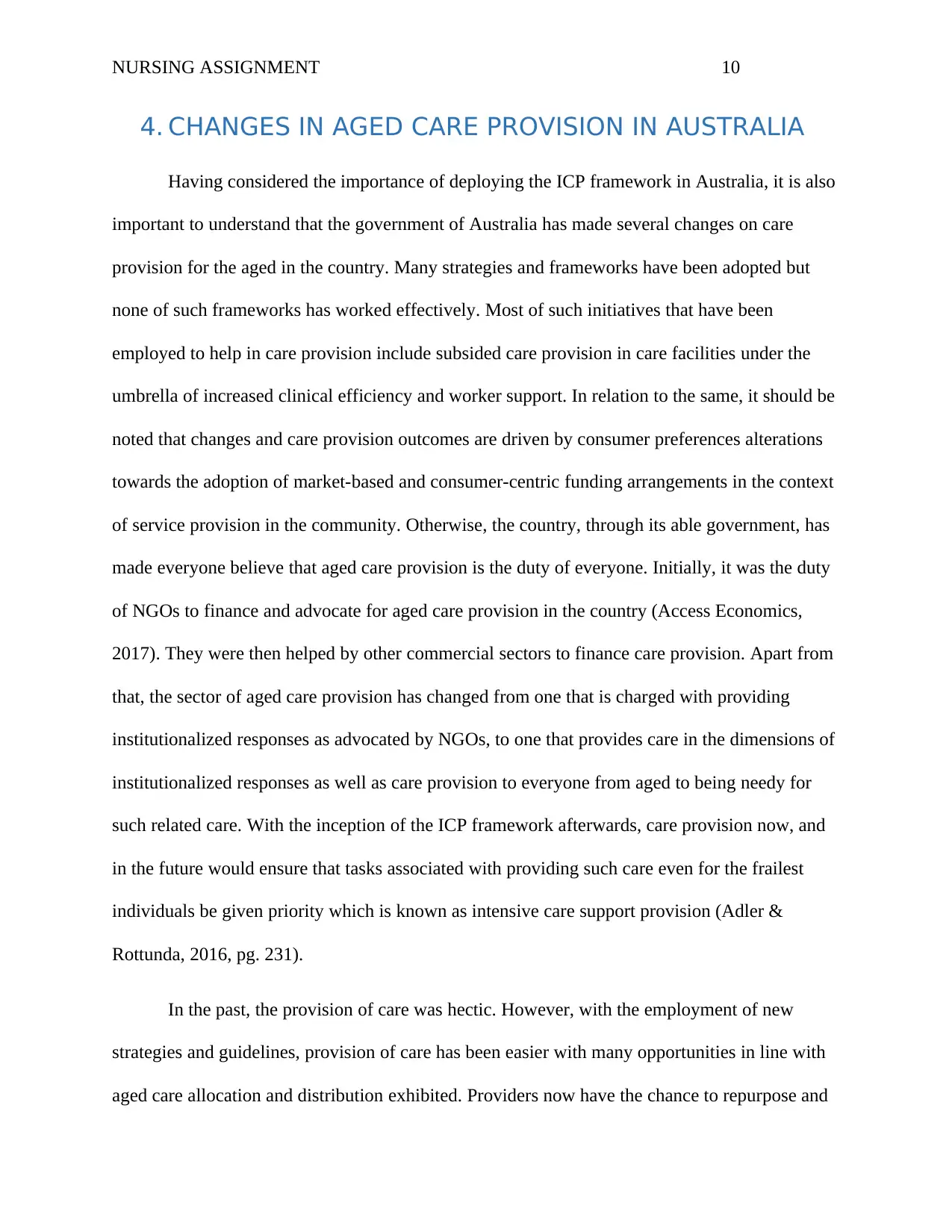
NURSING ASSIGNMENT 10
4. CHANGES IN AGED CARE PROVISION IN AUSTRALIA
Having considered the importance of deploying the ICP framework in Australia, it is also
important to understand that the government of Australia has made several changes on care
provision for the aged in the country. Many strategies and frameworks have been adopted but
none of such frameworks has worked effectively. Most of such initiatives that have been
employed to help in care provision include subsided care provision in care facilities under the
umbrella of increased clinical efficiency and worker support. In relation to the same, it should be
noted that changes and care provision outcomes are driven by consumer preferences alterations
towards the adoption of market-based and consumer-centric funding arrangements in the context
of service provision in the community. Otherwise, the country, through its able government, has
made everyone believe that aged care provision is the duty of everyone. Initially, it was the duty
of NGOs to finance and advocate for aged care provision in the country (Access Economics,
2017). They were then helped by other commercial sectors to finance care provision. Apart from
that, the sector of aged care provision has changed from one that is charged with providing
institutionalized responses as advocated by NGOs, to one that provides care in the dimensions of
institutionalized responses as well as care provision to everyone from aged to being needy for
such related care. With the inception of the ICP framework afterwards, care provision now, and
in the future would ensure that tasks associated with providing such care even for the frailest
individuals be given priority which is known as intensive care support provision (Adler &
Rottunda, 2016, pg. 231).
In the past, the provision of care was hectic. However, with the employment of new
strategies and guidelines, provision of care has been easier with many opportunities in line with
aged care allocation and distribution exhibited. Providers now have the chance to repurpose and
4. CHANGES IN AGED CARE PROVISION IN AUSTRALIA
Having considered the importance of deploying the ICP framework in Australia, it is also
important to understand that the government of Australia has made several changes on care
provision for the aged in the country. Many strategies and frameworks have been adopted but
none of such frameworks has worked effectively. Most of such initiatives that have been
employed to help in care provision include subsided care provision in care facilities under the
umbrella of increased clinical efficiency and worker support. In relation to the same, it should be
noted that changes and care provision outcomes are driven by consumer preferences alterations
towards the adoption of market-based and consumer-centric funding arrangements in the context
of service provision in the community. Otherwise, the country, through its able government, has
made everyone believe that aged care provision is the duty of everyone. Initially, it was the duty
of NGOs to finance and advocate for aged care provision in the country (Access Economics,
2017). They were then helped by other commercial sectors to finance care provision. Apart from
that, the sector of aged care provision has changed from one that is charged with providing
institutionalized responses as advocated by NGOs, to one that provides care in the dimensions of
institutionalized responses as well as care provision to everyone from aged to being needy for
such related care. With the inception of the ICP framework afterwards, care provision now, and
in the future would ensure that tasks associated with providing such care even for the frailest
individuals be given priority which is known as intensive care support provision (Adler &
Rottunda, 2016, pg. 231).
In the past, the provision of care was hectic. However, with the employment of new
strategies and guidelines, provision of care has been easier with many opportunities in line with
aged care allocation and distribution exhibited. Providers now have the chance to repurpose and
Paraphrase This Document
Need a fresh take? Get an instant paraphrase of this document with our AI Paraphraser

NURSING ASSIGNMENT 11
reorganize care provisions that no longer offer quality and help to the aged within the sector.
Likewise, such care providers have developed resort-styles that would ease accommodation and
provision of care for aged individuals to seek them in environments of high-end support. A
number of activities triggered changes in the sector such as the Productivity Commission report
of 2011. The Productivity Commission report of 2011 encouraged outcomes of a number of care
provision reforms. All the care provision reforms were intended to ensure that aged care systems
have the platform of displaying their effectiveness and the responses they offer in line with aged
care provision (Australian Bureau of Statistics, 2015). Such responses would gauge the efficacy
and methodology to which care provision systems would help aged individuals get consumer
centered services. Simply put, the initial costs of care provision packages before the reforms
were costly and most aged individuals could not afford them. However, since the country has
managed to implement a number of reforms in line with technological advancements, cost as a
factor of purchase has been driven from labor-intensive service delivery systems and components
of aged care. Systems of care provision that are currently used in the country and internationally
depend on technology and individual input to establish the manner in which care provision
information is collected along with accommodation provision (Child, Et al., 2013, pg. 3).
Finally yet importantly, care provision requires much labor input as advance clinical care
and patient health maintenance issues requiring skilled personnel. With input from technological
advances, however, challenges associated with skilled personnel has been on the rise for a couple
of years. First, the current workforce is required to be well informed about the existing
technological advances and develop the skills necessary to meet the changes that may have
occurred. Apart from that, the Australian Bureau of Statistics under the sector of human resource
shows that the aged care provision segment has close to 403,500 employees therefore, recording
reorganize care provisions that no longer offer quality and help to the aged within the sector.
Likewise, such care providers have developed resort-styles that would ease accommodation and
provision of care for aged individuals to seek them in environments of high-end support. A
number of activities triggered changes in the sector such as the Productivity Commission report
of 2011. The Productivity Commission report of 2011 encouraged outcomes of a number of care
provision reforms. All the care provision reforms were intended to ensure that aged care systems
have the platform of displaying their effectiveness and the responses they offer in line with aged
care provision (Australian Bureau of Statistics, 2015). Such responses would gauge the efficacy
and methodology to which care provision systems would help aged individuals get consumer
centered services. Simply put, the initial costs of care provision packages before the reforms
were costly and most aged individuals could not afford them. However, since the country has
managed to implement a number of reforms in line with technological advancements, cost as a
factor of purchase has been driven from labor-intensive service delivery systems and components
of aged care. Systems of care provision that are currently used in the country and internationally
depend on technology and individual input to establish the manner in which care provision
information is collected along with accommodation provision (Child, Et al., 2013, pg. 3).
Finally yet importantly, care provision requires much labor input as advance clinical care
and patient health maintenance issues requiring skilled personnel. With input from technological
advances, however, challenges associated with skilled personnel has been on the rise for a couple
of years. First, the current workforce is required to be well informed about the existing
technological advances and develop the skills necessary to meet the changes that may have
occurred. Apart from that, the Australian Bureau of Statistics under the sector of human resource
shows that the aged care provision segment has close to 403,500 employees therefore, recording
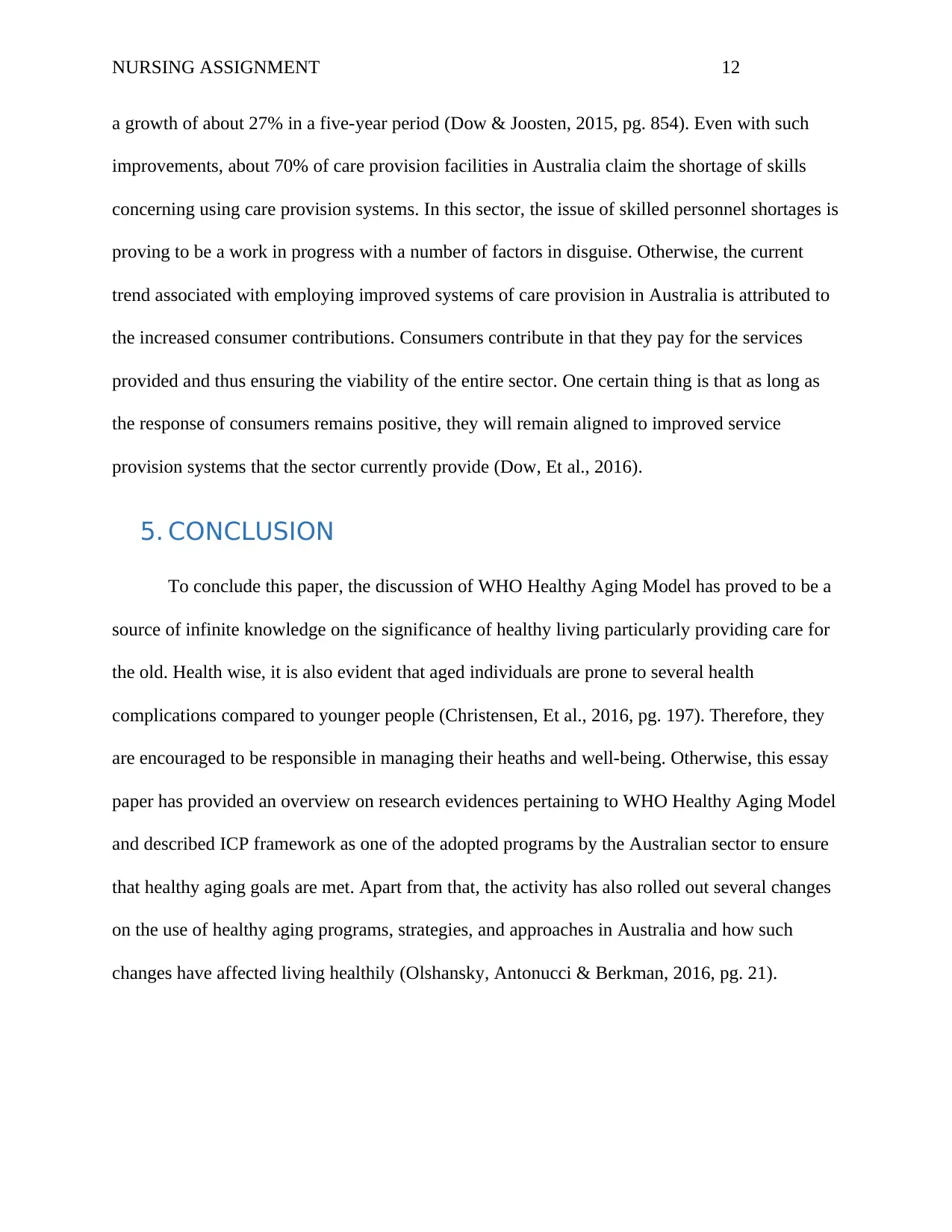
NURSING ASSIGNMENT 12
a growth of about 27% in a five-year period (Dow & Joosten, 2015, pg. 854). Even with such
improvements, about 70% of care provision facilities in Australia claim the shortage of skills
concerning using care provision systems. In this sector, the issue of skilled personnel shortages is
proving to be a work in progress with a number of factors in disguise. Otherwise, the current
trend associated with employing improved systems of care provision in Australia is attributed to
the increased consumer contributions. Consumers contribute in that they pay for the services
provided and thus ensuring the viability of the entire sector. One certain thing is that as long as
the response of consumers remains positive, they will remain aligned to improved service
provision systems that the sector currently provide (Dow, Et al., 2016).
5. CONCLUSION
To conclude this paper, the discussion of WHO Healthy Aging Model has proved to be a
source of infinite knowledge on the significance of healthy living particularly providing care for
the old. Health wise, it is also evident that aged individuals are prone to several health
complications compared to younger people (Christensen, Et al., 2016, pg. 197). Therefore, they
are encouraged to be responsible in managing their heaths and well-being. Otherwise, this essay
paper has provided an overview on research evidences pertaining to WHO Healthy Aging Model
and described ICP framework as one of the adopted programs by the Australian sector to ensure
that healthy aging goals are met. Apart from that, the activity has also rolled out several changes
on the use of healthy aging programs, strategies, and approaches in Australia and how such
changes have affected living healthily (Olshansky, Antonucci & Berkman, 2016, pg. 21).
a growth of about 27% in a five-year period (Dow & Joosten, 2015, pg. 854). Even with such
improvements, about 70% of care provision facilities in Australia claim the shortage of skills
concerning using care provision systems. In this sector, the issue of skilled personnel shortages is
proving to be a work in progress with a number of factors in disguise. Otherwise, the current
trend associated with employing improved systems of care provision in Australia is attributed to
the increased consumer contributions. Consumers contribute in that they pay for the services
provided and thus ensuring the viability of the entire sector. One certain thing is that as long as
the response of consumers remains positive, they will remain aligned to improved service
provision systems that the sector currently provide (Dow, Et al., 2016).
5. CONCLUSION
To conclude this paper, the discussion of WHO Healthy Aging Model has proved to be a
source of infinite knowledge on the significance of healthy living particularly providing care for
the old. Health wise, it is also evident that aged individuals are prone to several health
complications compared to younger people (Christensen, Et al., 2016, pg. 197). Therefore, they
are encouraged to be responsible in managing their heaths and well-being. Otherwise, this essay
paper has provided an overview on research evidences pertaining to WHO Healthy Aging Model
and described ICP framework as one of the adopted programs by the Australian sector to ensure
that healthy aging goals are met. Apart from that, the activity has also rolled out several changes
on the use of healthy aging programs, strategies, and approaches in Australia and how such
changes have affected living healthily (Olshansky, Antonucci & Berkman, 2016, pg. 21).
⊘ This is a preview!⊘
Do you want full access?
Subscribe today to unlock all pages.

Trusted by 1+ million students worldwide
1 out of 14
Related Documents
Your All-in-One AI-Powered Toolkit for Academic Success.
+13062052269
info@desklib.com
Available 24*7 on WhatsApp / Email
![[object Object]](/_next/static/media/star-bottom.7253800d.svg)
Unlock your academic potential
Copyright © 2020–2025 A2Z Services. All Rights Reserved. Developed and managed by ZUCOL.




